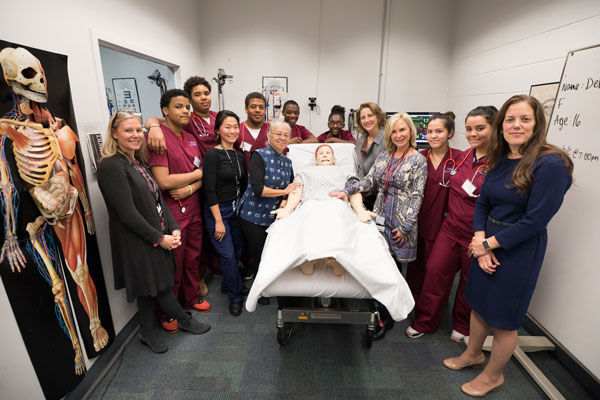
The patient is lying on a stretcher complaining of chest pain. Seven young people clad in scrubs rush to his side. Rapidly, one takes vital signs while another writes down the patient’s medical history and reviews current symptoms.
Blood tests are ordered, a drug-screen panel administered and an EKG is performed. The final diagnosis—drug overdose—is delivered not by a crew of trained medical professionals but by a group of high school students learning human physiology in the trenches.
The patient: A high-fidelity simulation mannequin named “Stan.” The place: Harvard Medical School MEDscience Simulation Lab.
On Nov. 17, a small group of students from Dorchester’s Community Academy of Science and Health performed this addiction simulation in front of Massachusetts First Lady Lauren Baker.
“We recognize that addiction is a priority for the governor, and the MEDscience curriculum is making an impact to educate students on the effects drugs can have on the body,” said Julie Joyal, executive director of HMS MEDscience High School STEM program.
MEDscience’s mission is to spark interest in science and medicine among high schoolers from urban and suburban public and private schools by allowing them an immersive experience in physiology and medicine.
The program also provides theoretical and practical knowledge in these fields and uses case-based studies, involving clinical simulation and realistic, high-fidelity mannequins. The idea is to teach concepts of physiology by different organ systems.
During weekly sessions over three months, students learn the process of differential diagnosis, critical thinking and problem solving while improving their personal health literacy and sharpening their teamwork and communication skills.
More than 800 students are currently enrolled in the program. The simulation cases vary by organ system.
One of the cornerstone scenarios of the program, now in its fifth year, is opioid addiction, which has become a national epidemic over the last decade.
Besides understanding the biology of addiction, the drill is an opportunity for students to get educated about the dangers of drug use.
“I wish I had this kind of hands-on learning when I was young because I was intimated by science,” said Lauren Baker, “and giving them this opportunity to explore a career path is such a gift.”


